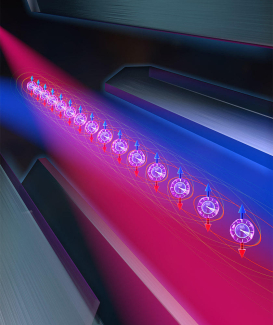Higher accuracy atomic clocks, such as the “tweezer clock” depicted here, could result from linking or “entangling” atoms in a new way through a method known as “spin squeezing,” in which one property of an atom is measured more precisely than is usually allowed in quantum mechanics by decreasing the precision in which a complementary property is measured.
JILA and NIST Fellow Ana Maria Rey and JILA Fellow and NIST Physicist Adam Kaufman have both been recently featured in an article for IEEE Spectrum. In a pair of Nature papers, Rey and Kaufman both demonstrated the phenomena of spin-squeezing to reduce noise in their quantum systems. "All objects that follow the rules of quantum physics can exist in multiple energy states at once, an effect known as superposition," explains the IEEE Spectrum article. "Spin squeezing reduces all those possible superposition states to just a few possibilities in some respects while expanding them in others."
Utilizing spin-squeezing, physicists like Kaufman and Rey can make more precise measurements for applications like atomic clocks or quantum sensors. “It opens an avenue to emulate infinite-range interaction,” says Rey in the article.
Read the full article here.



 The Physics Frontiers Centers (PFC) program supports university-based centers and institutes where the collective efforts of a larger group of individuals can enable transformational advances in the most promising research areas. The program is designed to foster major breakthroughs at the intellectual frontiers of physics by providing needed resources such as combinations of talents, skills, disciplines, and/or specialized infrastructure, not usually available to individual investigators or small groups, in an environment in which the collective efforts of the larger group can be shown to be seminal to promoting significant progress in the science and the education of students. PFCs also include creative, substantive activities aimed at enhancing education, broadening participation of traditionally underrepresented groups, and outreach to the scientific community and general public.
The Physics Frontiers Centers (PFC) program supports university-based centers and institutes where the collective efforts of a larger group of individuals can enable transformational advances in the most promising research areas. The program is designed to foster major breakthroughs at the intellectual frontiers of physics by providing needed resources such as combinations of talents, skills, disciplines, and/or specialized infrastructure, not usually available to individual investigators or small groups, in an environment in which the collective efforts of the larger group can be shown to be seminal to promoting significant progress in the science and the education of students. PFCs also include creative, substantive activities aimed at enhancing education, broadening participation of traditionally underrepresented groups, and outreach to the scientific community and general public.